Is this 'surreal nightmare' an unpublished photo of the Halifax Explosion?
"The photo has the look of a very troubling dream," Dan Conlin says as he studies an old black-and-white image.
Conlin is a transportation historian who's spent a lifetime studying images of ships, trains and aircraft. He's also a former curator of Halifax's Maritime Museum of the Atlantic, which houses a large collection of materials from the 1917 Halifax Explosion.
The image he's studying surfaced recently on Reddit with a user from Halifax, England, wondering if it was a "new" image of the 1917 disaster.
"You have these tranquil little wavelets in the foreground and some stately, anchored vessels — including a sailing ship," Conlin said. "But in the background there are these awful, nightmarish clouds, including a horrible column that is rising into the sky. It looks like a surreal nightmare."
When Conlin first looked at it, the crisp details of the foreground and the blurry background raised his skeptical eyebrows. "There was quite a tradition in the World War I era of faking photos by doing composite photos, where you layer one image on top of another," he said.
One well-known photo of the explosion taken from McNabs Island was later suspected to have been doctored by a company. They seem to have added clouds for dramatic effect — and to sell more postcards.
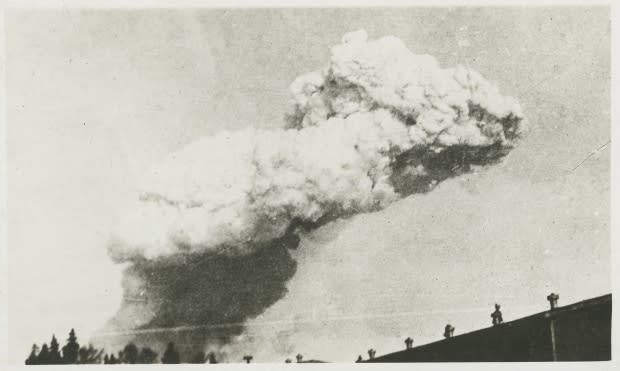
But Conlin thinks in the nightmarish photo, it's more likely that the clouds are moving from the force of the explosion, while the ships were untroubled by any winds. The disaster killed nearly 2,000 people and badly hurt thousands more. It levelled the Richmond district in the north end.
"It's carnage and destruction out of Dante at the base of that cloud. People are dying and fires are starting and this awful event has hit Halifax in the distance," he said.
"That angry cloud gives you an idea of the violence and tragedy that is unfolding even as the shutter clicks. It's really rare and that photo, as far as I can tell, has never been published."
Searching for 'RGS'
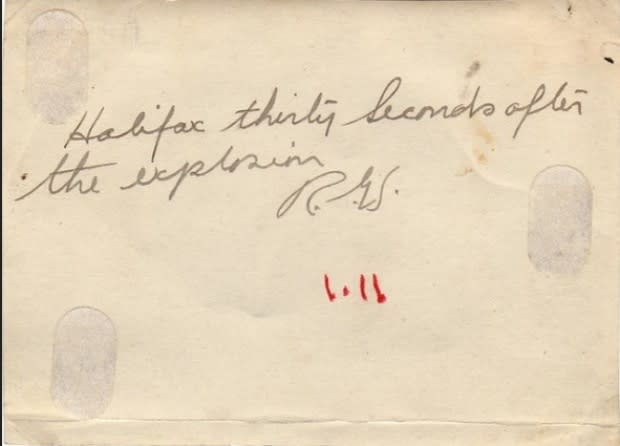
CBC News tracked down the source of the social media image to the Community Archives of Belleville and Hastings County in Ontario, where archivist Amanda Hill answered the phone.
She said the photo, which measures seven centimetres by 10 centimetres, entered their collection in 2012 as part of a donation of a personal album of photos taken between 1917 and 1919.
"It looks like it's been through the wars. The image is a bit battered and the image is kind of difficult to see," she said.
When Hill saw the coverage of the 100th anniversary of the explosion in 2017, she dug up the album and looked again at the smoke-cloud photo.
"On the back are written the words, 'Halifax 30 seconds after the explosion. RGS,'" she said.
Hill studied the album and realized some of the photos showed a sailor named Reginald Stevens. She did some more research and learned that his middle name was Garnet. She'd found the RGS who took the photo. "I have to admire his presence of mind," she said.
That was good evidence she was looking at an original photo, not a mass-printed image, and thus it might be new. She scanned it and posted it to their website.
But she couldn't find service records showing RGS had been in Halifax on Dec. 6, 1917, and in place to have taken the photo. "It would be interesting to look those up and see which ship he was on. That would place him in Halifax at the time of the explosion."

CBC sent the photo to Joel Zemel, who's written two books about the Halifax Explosion. He's studied hundreds of photos relating to the explosion and estimates fewer than 20 show the actual blast cloud. He's posted many of the known ones to his website.
"I haven't seen this one," he said.
He noted the clouds obscure the distance and it gives few clues as to where it was taken. The strange three-masted sailboat to the right seems out of place in the steam age, but could have been moored and hulked — that is, used as a floating warehouse.
The high angle limits where the photographer could be around the harbour. "One of the only vantage points that could take a photograph that high would be off HMCS Niobe, which was a depot ship in the harbour at the time."
The Niobe was anchored near what was then the Canadian naval college and today is CFB Stadacona. The explosion happened about 1.2 kilometres away, near today's Irving Shipyard.
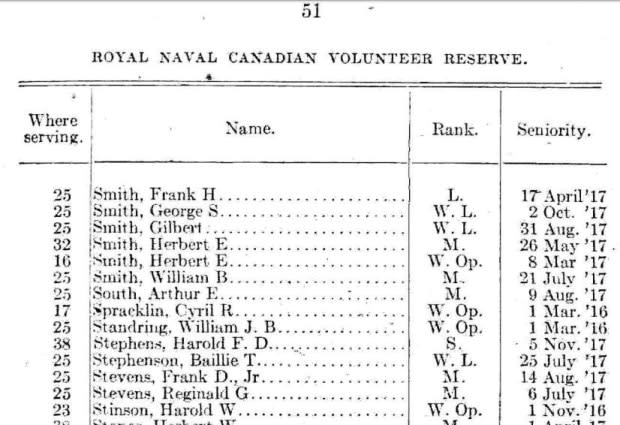
Zemel scoured his personal archives and drew a frustrating blank. He returned to the search the next day and double-checked the Canadian Navy List of personnel. Reginald G. Stevens was a mate in the Royal Canadian Volunteer Reserve.
"I had missed the key entry in my previous search. According to the Canadian Navy List, December 1917, Mate Stevens was indeed borne to HMCS Niobe," he said.
"Here we have a sailor who was in the right position at the right time to have taken this photograph. That gives it some credibility."
But Zemel said the time frame doesn't match eyewitness accounts from the Niobe.
"The water is very calm. That seems kind of strange, because within 30 seconds of the explosion, there would have been the tidal wave which came up on the Niobe."
One eyewitness from the Niobe reported that the blast had blown his jacket off and tossed the 11,000-tonne ship into the air, before she crashed back down. As soon as the boat stopped bouncing, they sprang into action to help those caught in the inferno.
Zemel concludes it's plausible that Stevens took the image from the Niobe, but not thirty seconds after the explosion. Perhaps it was a few minutes later, and when he finally printed the photo and wrote on it, he estimated it had only been thirty seconds.
Mysterious sailing ship
Zemel has tried extensively to identify the sailing ship in the photo. If he could name it, that could be the critical confirmation that the photo is what it claims to be. It would also confirm from where Stevens took the photo.
He scoured insurance records and lists of ships damaged by the explosion, but nothing matches it.
Zemel said the unidentified ship is driving him nuts. "I think the photograph is authentic. It's just this boat is an enigma."
Dan Conlin adds that while we have good lists of ships damaged by the explosion, we don't have lists of ships in the harbour that were not damaged by the explosion. So the mystery sailboat could have emerged unscathed and sailed on, dropping off the historical horizon.
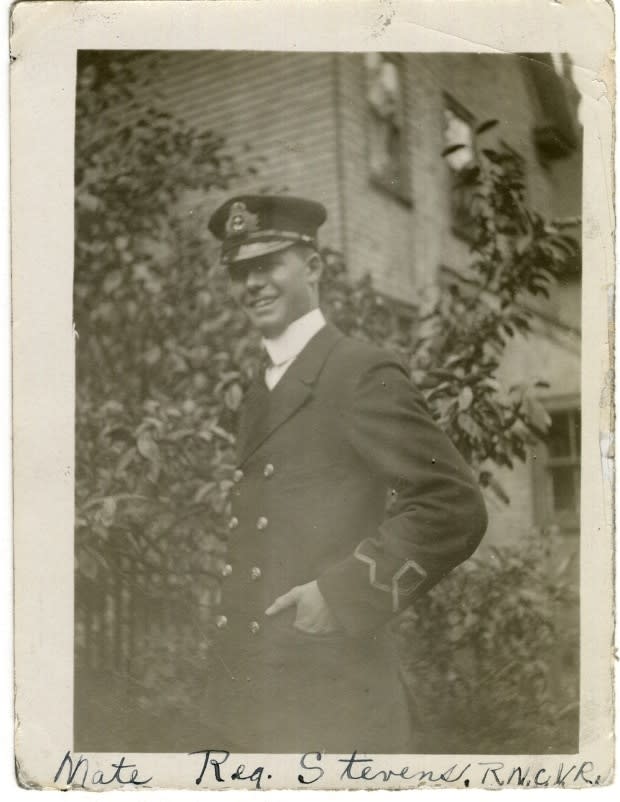
Amanda Hill, the archivist, praised Stevens's presence of mind to take the photo and wondered why he would have had a camera handy 103 years ago.
Conlin says in that regard, 1917 was a lot like 2020. People had been taking photos since the 1830s, but it was a cumbersome, expensive process. Only professional photographers took photos.
But Kodak had started selling its iconic Brownie cameras to the masses just before the war.
"People had the same urge that we have nowadays to snap photos of friends and relatives. They were using this new technology to take pictures of family and neighbours and houses and their first car and buddies in the military," Conlin said.
"Sailors love to show families what they've seen when they go back home."
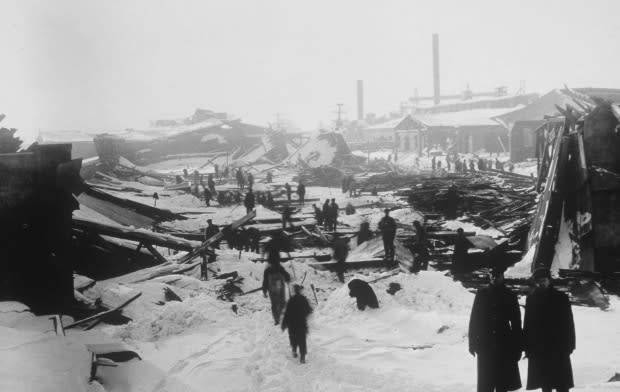
Conlin noted that the Niobe was an anchored ship at the time and served as a floating barracks. "There were all kinds of people who were assigned to Niobe, but would work in other parts of the dockyard or the harbour," he said.
That means even if we can show the RGS who took the photo was the Reginald Garnet Stevens stationed to the Niobe, and that the Niobe was in the harbour at the time of the explosion, and that the angle of the photo matches the angle from the Niobe, the exact location of the photo escapes us.
Stevens could have taken it from the Bedford Basin looking south to the Narrows, or near Georges Island, looking north to the disaster.
Identifying that sailing ship, or finding a diary entry from Stevens saying he took the photo on the day of the disaster, would likely be enough to confirm it 100 per cent.
"The explosion happened over a hundred years ago, but it still has surprises for us," Conlin said. "This picture is a real reminder of that."

MORE TOP STORIES


